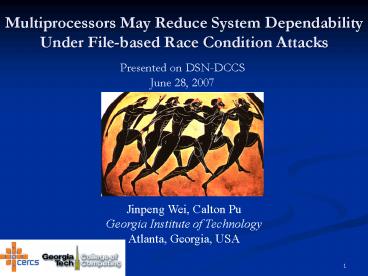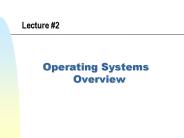Multiprocessors May Reduce System Dependability Under Filebased Race Condition Attacks
1 / 30
Title:
Multiprocessors May Reduce System Dependability Under Filebased Race Condition Attacks
Description:
Attacker can become faster in a race condition attack, thus making the system less secure. ... The race between gedit and the attacker for the semaphore decides ... –
Number of Views:40
Avg rating:3.0/5.0
Title: Multiprocessors May Reduce System Dependability Under Filebased Race Condition Attacks
1
Multiprocessors May Reduce System Dependability
Under File-based Race Condition Attacks
Presented on DSN-DCCS June 28, 2007
Jinpeng Wei, Calton Pu Georgia Institute of
Technology Atlanta, Georgia, USA
2
System Dependability Brief History
- Traditionally focused on availability and
reliability (have redundancy, keep running) - Now security and safety are urgent issues
- Widely deployed software systems have bugs
- Software systems are under constant attacks.
intended behavior ! actual behavior
3
Multiprocessors Boon or Bane?
- Definitely they are good
- Better performance
- Lower power consumption
- More secure Intrusion detection systems
- Unless they fall in bad hands...
- Attacker can become faster in a race condition
attack, thus making the system less secure.
4
Its Much Easier to Attack TOCTTOU
Vulnerabilities on Multiprocessors
5
Agenda
- Background about TOCTTOU and the vulnerabilities
with vi and gedit - A probabilistic model for TOCTTOU attacks
- Probability analysis of exploiting vi
- Probability and event analysis of exploiting
gedit - Parallelizing the attack program on a
multiprocessor - Conclusion
6
Definition and Scope
- TOCTTOU Time of Check To Time of Use, a kind of
file-based race condition in Unix-style systems - Check Establish some precondition (invariant)
about a file - Use Operate on the file assuming that the
invariant is still valid
7
Sendmail Example
- Run as root
- Operate on files owned by normal users
/home/abc/mailbox a symbolic link?
Yes
Error handling
Check
Establishing the invariant /home/abc/mailbox is
NOT a symbolic link
No
Append the new message to /home/abc/mailbox
Use
Assuming the invariant still holds
8
Sendmail Vulnerability An Example
Sendmail (root)
Attacker (abc)
Time
/home/abc/mailbox a symbolic link?
Check
Delete /home/abc/mailbox Create symbolic link
mailbox, pointing to /etc/passwd
No
Append the new message to /home/abc/mailbox
(actually to /etc/passwd)
Use
Effect The attacker may get unauthorized root
access!
9
TOCTTOU Vulnerabilities in Red Hat Linux 9 1
Tested 130 utilities from /bin, /sbin and
/usr/bin
1 Jinpeng Wei, Calton Pu. FAST05
10
vi 6.1 Vulnerability
- The vulnerability happens when
- vi is run by root
- vi is editing a file owned by a normal user (also
the attacker) - vi saves the file being edited
- TOCTTOU pair ltopen, chowngt
- open creates a new file for writing
- chown changes the owner of the new file to the
normal user.
while ((fd mch_open((char )wfname,
) chown((char)wfname, st_old.st_uid,
st_old.st_gid)
11
gedit 2.8.3 Vulnerability
- Similar to the vi vulnerability
- gedit is run by root
- gedit is editing a file owned by a normal user
(also the attacker) - gedit saves the file being edited
- TOCTTOU pair ltrename, chowngt
- rename creates a new file
- chown changes the owner of the new file to the
normal user.
/create and write to temp_filename / if
(rename (temp_filename, real_filename) ! 0)
chmod (real_filename, st.st_mode) chown
(real_filename, st.st_uid, st.st_gid)
12
An Attack Program
1 while (!finish) 2 if (stat(filename,
stbuf) 0) 3 if ((stbuf.st_uid 0)
(stbuf.st_gid 0)) 4 5
unlink(filename) 6
symlink(/etc/passwd, filename) 7
finish 1 8 9 10
- Observation the file owner temporarily becomes
root during the vulnerability window. - Simple, brutal-force.
13
Event Analysis of vi Exploit on a Uniprocessor
14
Agenda
- Background about TOCTTOU and the vulnerabilities
with vi and gedit - A probabilistic model for TOCTTOU attacks
- Probability analysis of exploiting vi
- Probability and event analysis of exploiting
gedit - Parallelizing the attack program on a
multiprocessor - Conclusion
15
Some Definitions for the Probabilistic Model
- Window of Vulnerability the time interval
between check and use (e.g., ltopen, chowngt). - Attack pattern detection attack
- detection can be run 1 or more times
- attack can be run 0 or 1 time
- Three process states
- Suspended unable to run (relinquishing CPU)
- Scheduled able to run (using CPU)
- Finished finished the attack actions (symbolic
link replacement, etc)
16
A Probabilistic Model for Predicting TOCTTOU
Attack Success Rate
P (attack succeeds) P (victim suspended) P
(attack scheduled victim suspended) P (attack
finished victim suspended) P (victim not
suspended) P (attack scheduled victim not
suspended) P (attack finished victim not
suspended)
- P (attack succeeds) on a multiprocessor is not
less than that on a uniprocessor, because of the
second part of the equation. - P (attack scheduled victim not suspended) 0
on a uniprocessor - Success gain due to the second part may become
significant when P (victim suspended) is very
small. - But wait, can the attack finished?
17
P (attack finished victim not suspended)
The answer
- D detection time, L t2 - t1 (Laxity)
- t1 the earliest start time for a successful
detection - t2 the latest start time for a successful
detection leading to a successful attack
18
Agenda
- Background about TOCTTOU and the vulnerabilities
with vi and gedit - A probabilistic model for TOCTTOU attacks
- Probability analysis of exploiting vi
- Probability and event analysis of exploiting
gedit - Parallelizing the attack program on a
multiprocessor - Conclusion
19
Success Rate of Attacking Vi on a Uniprocessor
- Between 1.5 and 18
- Approaches 0 when file size approaches 0
while ((fd mch_open((char )wfname, ) /
writing to wfname using fd/ chown((char)wfname,
st_old.st_uid, st_old.st_gid)
20
Success Rate of Attacking Vi on a SMP
- 100 for files with size gt20KB
- L gtgt D
- 96 for files with 1 byte
- L and D become close
- Attack may not be scheduled
21
Agenda
- Background about TOCTTOU and the vulnerabilities
with vi and gedit - A probabilistic model for TOCTTOU attacks
- Probability analysis of exploiting vi
- Probability and event analysis of exploiting
gedit - Parallelizing the attack program on a
multiprocessor - Conclusion
22
gedit Attack Success Rates
- 0 on a uniprocessor
- 83 on a SMP (2 x 1.7G CPUs, 512MB memory)
- The delay between rename and chmod is an
important contributing factor to L. It is 43
microseconds on the SMP.
Table L and D values in microseconds (SMP)
if (rename (temp_filename, real_filename) ! 0)
chmod (real_filename, st.st_mode) chown
(real_filename, st.st_uid, st.st_gid)
23
gedit Attack on a Multicore
- 2 x 3.2G dual-core CPUs with HT, 4GB memory
- No success at all !
- Why ?
24
New Observation on the gedit Attack
- CPU is a necessary but not sufficient condition
for a successful attack - Semaphore on the shared file is another necessary
condition - The race between gedit and the attacker for the
semaphore decides the attack result
- The delay between stat and unlink of the attacker
is 17 us. - The delay between rename and chmod is now only 3
us. - There is a 6 us trap (due to page fault) within
the 17 us of the attacker.
25
Rethinking the gedit Attack Program
1 while (!finish) 2 if (stat(filename,
stbuf) 0) 3 if ((stbuf.st_uid 0)
(stbuf.st_gid 0)) 4 5
unlink(filename) 6
symlink(/etc/passwd, filename) 7
finish 1 8 9 10
- There is a trap when the true branch of statement
3 is taken, because unlink is never invoked
before by the attacker - Linux kernel dynamically maps shard libraries
(e.g., libc) into an applications address space.
26
The Solution
- Proactively invoke unlink to remove the trap.
1 while (!finish) / argv1 holds filename
/ 2 if (stat(argv1, stbuf) 0) 3
if ((stbuf.st_uid 0) (stbuf.st_gid
0)) 4 5 fname
argv1 6 finish 1 7
8 else 9 fname
dummy 10 11 unlink(fname) 12
symlink(/etc/passwd, fname) 13 //if
stat(argv1 .. 14 //while
27
New gedit Attack on a Multicore
- Started to see successes.
- The trap disappeared
28
Agenda
- Background about TOCTTOU and the vulnerabilities
with vi and gedit - A probabilistic model for TOCTTOU attacks
- Probability analysis of exploiting vi
- Probability and event analysis of exploiting
gedit - Parallelizing the attack program on a
multiprocessor - Conclusion
29
Pipelining Attack Program
- symlink needs not wait on the completion of
unlink, so we can make the attack program
multi-threaded - The attack can finish much earlier when the
shared file is large, giving advantage when the
vulnerability window is very small
30
Conclusion
- A probabilistic model for TOCTTOU attacks which
captures the reduced system dependability by the
deployment of multiprocessors - Probability measurement and event analysis of
exploiting vi and gedit, which corroborate the
model and demonstrate how the attacker may
utilize multiprocessors to achieve higher success
rate.































